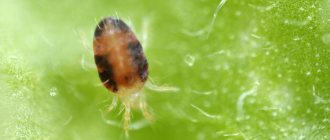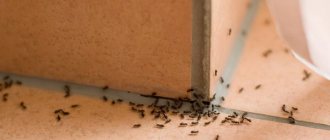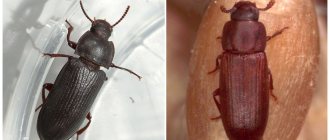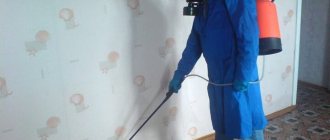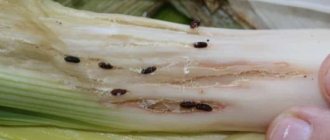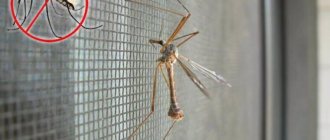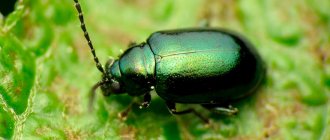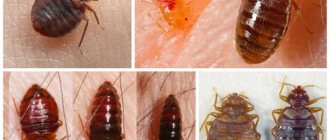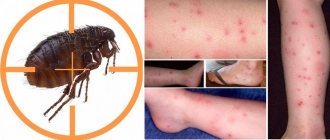Author: V_V_V
10 January 2022 15:29
Tags: brrrrrrrr house insects
487745
16
Do you know all your neighbors? Sure? Some of them are so small that you simply can’t see them. Insects live in almost every home. This is a fact: even if you don’t see them, this almost always means that the “roommates” are simply hiding very successfully. In some cases, insects in an apartment are absolutely harmless, but some of their species pose a serious danger not only to food and things, but also to the person himself. In general, get acquainted!
0
Source:
See all photos in the gallery
For thousands of years, people have sought shelter, starting with the first cave, then building shelters from tree branches and leaves, and making tents from animal skins. As time passed and additional tools were developed, humanity began to build houses from strong wood and stone, and houses appeared. And always, from the very first home, various insects lived next to a person. Today we see them as uninvited guests and prefer to live without them. But if you think about it, they were before us, and they will be after us. For your consideration, here is a list of 15 small creatures with whom you may share your home. They are also called synanthropes (non-domesticated plants and microorganisms whose lifestyle is associated with humans and their homes, for example, cockroaches, house flies, house mice, bed bugs).
Spiders
0
Source:
Spiders are probably one of the most common creatures with which we share our homes, and some of these arachnids will appear on this list more than once. There is a great variety of spiders in nature, more than 45,000 different species. Overall, modern spiders have spread throughout the world over the past 200 million years, which is largely responsible for their wide distribution and diversity. The spider does not do anything bad in the house, sometimes it even does good - it catches flies. Our ancestors had a huge number of signs associated with spiders, mostly positive. They say spiders are harbingers of good things to come. But, probably, if you trust signs too much, you will be completely covered in cobwebs.
×
Ground beetles
0
Source:
Just like spiders, beetles are very ancient and well-adapted creatures for survival. There are more than 40,000 species of ground beetles alone in the world, and these insects come to our homes uninvited. The most common is the bread ground beetle. They usually cause damage to crops in fields, but are increasingly found in ordinary apartments. The bread ground beetle crawls into the apartment only if it likes the living conditions. As soon as the insect gets into the house, when darkness falls, it goes to look for food (crumbs, food left on the table, cereals). Ground beetles interfere with sleep, rustle, fall from the ceiling onto the bed or directly onto you. And if they have found food, then the next step will be their reproduction. So, if a ground beetle appears in the house, you need to take immediate action.
Weevils
Other guests may also come into the apartment along with the cereal: small insects with an egg-shaped abdomen and a strongly elongated proboscis on the head. The color of the bugs is dark brown or black. These are granary or rice weevils. They feed on grain, preferring already crushed seeds. The length of weevils is 2.3-3.5 mm. The larva is light yellow, up to 3 mm long. The larva has a short head and no legs.
On a note!
The weevil does not fly, so it can only get into the apartment along with spoiled cereal from the store.
Crickets
0
Source:
The wise cricket who gave advice to Pinocchio probably looked something different. And ordinary crickets are creepy insects, sometimes of enormous size. A folk sign says that if there is a cricket in the house, then this is a sign of happiness and prosperity. But people who have been visited by this “happiness” in large numbers do not share this point of view and are looking for ways to get rid of them. About 2.3 thousand species of these insects are known in the world, of which only about 50 are found in Russia. Most of them live in subtropical and tropical countries. Our most famous species are the field cricket and the house cricket. The house cricket in the southern part of the country lives both in apartments and in nature. In the central and northern regions, it lives only in houses near people, and gives preference to old, warm rooms with high humidity. These insects live and breed well in warm basements flooded with water. Sometimes crickets can spoil food and even things in the apartment, just like moths. Therefore, although popular wisdom advises against offending them, it is better to remove the crickets. Unless, of course, you like the “night concerts” that crickets usually organize.
Carpet beetles in an apartment, how to get rid of them?
From everything stated above, it is clear that the destruction of skin beetles must begin immediately as soon as this abomination is discovered and identified. This is the only way to avoid losses due to unwanted proximity to parasites. All insect repellents are good in the fight against insects.
Photo: https://sandezeco.ru/wp-content/uploads/2019/09/zhuk-kozheed.jpg
Moreover, our market has a wide selection of insecticides in different forms:
- Tablets are best suited for protecting clothing from skin beetles. These are the well-known drugs “Dezmol”, “Supronit”, “Antimol” and others. They are laid out in closets and drawers where clothes are stored. These forms of pesticides act on an ongoing basis for a long time. Therefore, there will be no trace of skin beetles left in a couple of weeks.
- Aerosols . Particles of poisons sprayed onto parasites penetrate through the chitinous shells, causing paralysis in the nervous system of insects. This is followed by their death. However, eggs and pupae remain alive when treated with aerosols. Therefore, it has to be repeated several times at certain intervals. Along with the well-known Karbofos and Dichlorvos, Raid, Raptor and Clean House work well. But you cannot treat clothes with them, since their vapors are also toxic to humans.
- Powders . They can be poured into cracks under baseboards, under window sills and cabinets, inside sofas, armchairs and any other furniture. Powdered insecticides with boric acid and permethrin are considered the best. In addition to being used in dry form, they are diluted in water for spraying in places where insects accumulate.
- Concentrates are applied over the entire area of the room or in individual corners. They do not leave stains behind and do not damage surfaces. But still, especially valuable things are placed in plastic bags before disinfection and immersed in the concentrate for 2 hours. When treating premises, the effect of the concentrates lasts for a month and thereby ensures complete cleansing of parasites and their offspring. The most popular among concentrated poisons are Executioner and Tetrix.
The main thing is to follow the instructions for each drug and prepare the solutions correctly. After spraying aerosol forms, drafts should be provided for ventilation 2 hours later.
Freezing
Among non-chemical methods, exposure to sub-zero temperatures is sometimes used. However, the beetles are quite resistant to light frosts and die only at -11 and below. Particularly persistent individuals can hibernate, and when warmth is restored they come to life. Therefore, to be safe, the rooms are kept at -20 for several hours.
It is recommended to periodically repeat the frost exposure. But such low temperatures do not always occur even in winter. And not all owners will agree to risk freezing the water in the heating system in order to get rid of skin beetles.
Book louse
0
Source:
If you hear the word “louse,” the first thing that probably comes to mind is the little reptiles that jump from head to head and feed on your blood, making your head itchy unbearably. These tiny creatures are their relatives, but live in books. They don’t read books, they don’t even have eyes! The book louse or book louse (Troctes divinatorius) is a small parasite that, with a large brood, causes irreparable damage to libraries, herbarium or insect collections, and in some conditions, to stocks of grain and other dry products. It feeds on organic remains of plant and animal origin. In houses he lives in dust and in the bindings of books. May damage zoological collections and bindings of ancient books containing paste. Clusters of book lice make faint ticking sounds that cannot be confused with anything. These insects do not have a detrimental effect on human health, but their presence can have a detrimental effect on valuable things: books, archival documents; on food stocks. The main preventive measure can be considered basic cleanliness, dryness and fresh air, in other words, timely cleaning.
Grinder
There is another type of harmful bugs that appear in the kitchen. They are called Grinders (“Anobiidae” in Latin). Their head is shaped like a hood. Their body color ranges from dark yellow to brown. There are two types: brownie and bread.
In our cities, as a rule, there is a bread grinder. It is smaller in size than the brownie and, in addition to wood, feeds on bread and crackers.
It can also lay eggs in books. Let's figure out how to get rid of bugs in the kitchen.
How to fight
- Seal all the wooden cracks - the floor, the window sill, the cracks in the kitchen furniture, in general, everything you find.
- Seal the entire cereal hermetically. No bags, only dishes that are sealed tightly.
- They love sweets and carbohydrates. It is better to put all dried fruits in the refrigerator.
- Place borax on the shelves; you can buy it at the pharmacy. But spraying with various chemicals is not the best solution.
If there are bugs in the cereal, this is not a sign of poor quality cleaning in the residential area. The bug appears for other reasons. To effectively combat it, you need to follow a number of simple recommendations. Preventive measures will help get rid of insects in cereals, preventing severe infestation.
The main factor that leads to the emergence of pests in flour and cereals is low quality and the complete lack of heat treatment or insufficiently high temperatures during this process. Another reason is violation of storage conditions for flour and cereal products. Because of this, beetles are found in rice or semolina, and in sealed packages.
Things are much simpler with loose products. At the same time, bugs appear in cereals more often, since they are close to contaminated flour. In the kitchen, insects switch to clean food as a result of loose lids on storage containers. Bugs can appear even if you purchase clean cereals, however, if you borrow even a small amount of contaminated flour, rice, or buckwheat from your neighbors, it is highly likely that the insects will now spread to other products in the kitchen.
If you find some bugs in flour: you need to determine their type as quickly as possible and begin eliminating them
Moreover, pests choose not only cereals, but also dried fruits, tea, coffee, and spices to infest. Most dry foods become contaminated using the methods described above. If there are bugs in the cereal, they are difficult to notice due to their very small size, especially when the dry product is dark in color and has large fractions.
Carpet mite
0
Source:
Scientists have found more than 1,000 different species of house ticks, and all of them cause great harm to humans, all year round. Any carpet or carpet perfectly collects dust, it accumulates in its fibers and even daily cleaning will not give a positive result - dust and mites will still remain there. Ticks, unlike most insects on this list, are very harmful to humans. The ticks themselves are capable of leaving behind their waste products in the form of feces, which contain digestive enzymes, they destroy the cells of the human body and can cause severe allergies and asthma. The damage caused by carpet mites is not limited to allergies: conjunctivitis, allergic rhinitis, atypical dermatitis and others can develop. It’s easy to deal with them - throw away all carpets and upholstered furniture once and for all!
Dark winged mosquito
0
Source:
The main harm is that they squeak and interfere with sleep! Thank God, humanity has invented many ways to get rid of mosquitoes. Mosquito nets, repellents and fumigators are a whole industry. Place fresh branches of elderberry, bird cherry, Caucasian chamomile or basil in the rooms, and place a container with tomato seedlings or geranium in a pot under the windows and on the balcony. Mosquitoes do not like the smell of these plants, so they will want to leave your home as soon as possible. According to folk superstitions, these small, disgustingly buzzing bloodsuckers - mosquitoes - are capable of bringing not only absolute harm, but also benefit, predicting the weather and future events. Clouds of mosquitoes mean good weather tomorrow. Painful mosquito bites and especially active buzzing of bloodsuckers - foretells imminent bad weather and night rain.
Lifehacks for getting rid of brown bugs
There is a more humane way of fighting, but it applies not to insects, but to food. For many, throwing away cereals is an unaffordable luxury.
If pests have left their mark on it, you can do the following:
- Sort and sift well through a fine sieve.
- Heat in the oven or place bags of cereal in the freezer for several days.
- You need to use it first.
- Treat the surfaces of the cabinets with vinegar, boric acid or laundry soap (rub it and make a solution).
- Pour boiling water over the cracks.
- Wash the dishes to completely get rid of derivative bugs.
The vacuum cleaner will suck out hidden parasites and their larvae from all the cracks. After the procedure, the dust collector or garbage bag is thrown away or, once emptied, frozen for 3-4 days to prevent re-infection.
As soon as the cereal is placed in the boxes again, “traps” are installed. To do this, pour a little sunflower oil into small containers; the remaining beetles, which will drown in it, will definitely come for a treat.
Spitting spider
0
Source:
As mentioned earlier, this list will feature more than one species of spider. Spiders of this species catch prey by spraying a liquid onto it, which neutralizes it by solidifying into a toxic and sticky mass upon contact. You can observe the habit of spiders swaying from side to side. They do this to wrap up their prey. Most spiders are only capable of producing silk, but Scytodes spitting spiders are an exception. Together with the silk, they release poison from their mouths, and silk strands soaked in the toxin, falling on the spider’s victim, bind it. These spiders are not dangerous to humans, do not weave large trap webs, and are unremarkable in appearance. But they still have one peculiarity - during the hunt they “spit” their prey. This may sound a little harsh, but it's accurate. This is why they got their name “spits”. Spitting spiders live in both warm tropical and temperate regions, including Russia - in human homes, where it is warm.
clothes moth
0
Source:
Moths inhabit houses and are a household pest, whose caterpillars spoil fabrics by eating them and gnaw the silk upholstery of furniture. Only caterpillars cause damage to products, because adults lack gnawing type mouthparts. In the dark at night, adult moths fly towards an artificial light source. According to some data, house moth caterpillars also feed on substances of plant origin, namely grains of wheat, barley, oats, corn, flour and dry bread. House moths are widespread worldwide; this species of lepidoptera is a serious pest in human homes. They feed on clothing, carpets, blankets and upholstery, as well as fur, wool, feathers and miscellaneous items such as animal bristles used to make toothbrushes and piano fibers.
Woodlice
0
Source:
Generally speaking, woodlice are not insects (they are crustaceans), but they lead approximately the same lifestyle as cockroaches. When threatened, they curl up, simulating death. In most cases, wood lice appear only in those apartments where it is constantly damp, for example, water leaks from pipes. These insects are excellent indicators of various plumbing breakdowns and depressurization of flanges. The appearance of woodlice in an apartment, first of all, should worry lovers of indoor flowers, because if measures are not taken in time and they are not removed, the plants will soon die. First of all, these insects harm moisture-loving tropical plants that have a thin and delicate root system (orchid, fern, cactus), affecting it specifically, so if you have just such plants, then you should fight more actively.
Mucoeds
They are polyphagous beetles, that is, their menu is very diverse. Three types can be found in apartments.
Surinamese
A beetle 3-3.5 mm long with a red-brown back. The pest is flat, very elongated in length, with a thin body. The pronotum has characteristic longitudinal “ribs”.
Prefers bakeries as a bottomless source of nutrition. But often, along with flour and cereals, it gets into apartments, where it infects other supplies. The vital activity of bugs leads to an increase in humidity in products, which is why mold forms in cereals.
Maximum lifespan 3 years. Usual 6-10 months. The life cycle is 27-51 days at a temperature of 29-35°C.
During her life, the female lays 43-285 eggs. At an ideal temperature of 27-29°C, the larvae hatch after 3-5 days. The larva grows up to 3 mm, has a yellow-white color and a brown head.
Red mukoed
The light brown beetle is approximately 2 times smaller than its Surinamese “brother”. In the apartment, the food supply, habitats and life cycle are similar to those of the Suriname mucoedeater. A distinctive feature of the red mucous eater is inactivity.
Mucoeds
Merchant beetle
A flat small beetle, 2.5 cm long. Almost completely identical to the Surinamese beetle in morphology and lifestyle, differing in eye size and head shape. The bugs crawl actively, moving to new habitats.
Parasitic wasp (rider)
0
Source:
They are primarily parasitoids of other animals, mainly other arthropods. Many of them, such as the Braconidae family and Trichogramma, are beneficial to humans because they regulate the number of agricultural pests. Ichneumon wasps differ from ordinary wasps in the absence of a sting as such; it is replaced by an ovipositor. Nevertheless, in the English-language literature, parasitic wasps are usually called parasitic wasps. With the help of an ovipositor, parasites lay eggs in the body of larvae (caterpillars) or in the eggs of their victims. The prey consists mainly of larger insects, such as butterfly caterpillars, beetle larvae, and other arthropods, including some species of spiders. The rider typically positions himself over the victim (like a rider on a horse, hence the name) and inserts the ovipositor. The wasp larvae hatch inside the victim and feed on their organs, gradually destroying them. Species of the genus Megarhyssa of the superfamily Ichneumonidae have a thin ovipositor several centimeters long, used for penetration into tree trunks. Fortunately, people are not considered suitable incubators for wasp babies and it does not lay larvae in humans.
Ways to deal with “kitchen guests”
If traces of the vital activity of bugs are detected, you will need to take a set of measures to eliminate them from the open spaces of your kitchen. There are several ways to get rid of “unwanted guests”:
- Products of the household industry.
- Using folk remedies.
But chemicals are not always effective and have a lot of side effects on human health. They are used only in advanced cases when folk remedies are not able to get rid of insects.
If small brown bugs appear in the kitchen, then you need to:
- Get rid of cereals where small insects have settled.
- Thoroughly wash the containers in which cereals were stored. Dishes are washed with soapy water.
You can get rid of small bugs using folk remedies using vinegar. Initially, all cereals are destroyed, then the dishes are washed with a vinegar solution. Don't worry about the smell, there won't be any.
Many housewives are interested in how to get rid of annoying insects at home without using household chemicals. The answer is clear: if you need to preserve the product, you will need to adhere to such actions as:
- We sort through the cereal.
- Turn on the oven to 50 degrees or heat the frying pan.
- We calcinate or fry the cereal for ten minutes, but no more, in order to avoid spoilage of the product.
Not all cereals are subject to heat treatment. Pasta, rice, buckwheat, pearl barley and millet tolerate this process normally. But this method is not recommended for use with sugar, because it will simply melt.
After this is done, the remaining supplies are packed into separate bags and taken outside the kitchen for a week. This is done for reinsurance. If surviving insects appear, they will not be able to move into other cereals and spoil them. You can get rid of white bugs by exposing the insects to cold or ventilating the room.
Ants
0
Source:
At different times of the year and in different regions of the country, in an apartment, and even more so in a private house, you can often find representatives of various species of ants. Very often, ants in an apartment are random guests, carried on clothes or with things. Among them there are insects of different sizes and colors. However, the only real pest in an apartment is the so-called pharaoh ant - an independent species of heat-loving small ants, which in our latitudes cannot live anywhere other than residential heated premises. These red ants in the apartment are a real problem: they are numerous, spoil food, can carry pathogens of various diseases, and besides, they are extremely difficult to remove. One colony of house ants can contain several dozen queens and up to 350 thousand workers. The reasons why red ants appear in an apartment, although not numerous, can be found in almost any home. That is why small red ants are successfully conquering more and more new areas and are likely to appear in any apartment, even the cleanest one.
It is not always possible to see skin beetles clearly with the naked eye.
The main problem here is size: most skin beetles reach a length of only 3-4 mm, and even from a distance of 20-30 cm, the structural features of their body are not particularly striking. And for older people with poor eyesight, these insects are generally practically invisible, and even if noticeable, they are not recognizable.
In addition, even the larvae of skin beetles are not always easy to see. For example, in the photograph, when zoomed in significantly, the larvae of the furniture leather beetle look like this:
But in reality, the foam rubber inside the bed looks completely different:
Similarly, this is what a place of settlement of several larvae inside a slipper looks like:
And this is a small skin beetle larva on a sweater:
Agree, it will be very difficult to identify them here, from macro photographs by professional photographers. Despite the fact that…
Silverfish (common silverfish)
0
Source:
You may have once seen them in the bathroom or toilet if you went there in the middle of the night (when the light is turned on, they quickly run away). Those thin, silvery, small things on the floor? Do you remember? They are called silverfish. Like most of the other creatures on this list, silverfish pose no real harm to us and they don't bite. Cases of contact did not reveal any negative impact on human health. They feed on products of plant origin containing starch or polysaccharides; but they may not eat anything for months. Their diet may include sugar, flour, glue, book binding, paper, photographs, starchy fabrics. From storage areas they can be brought into the home through the purchase of toilet paper or cartons of paper napkins. They are harmless to humans and pets and are not carriers of diseases, but can damage damp paper. Their scientific name is “common silverfish” (lat. Lepisma saccharina). It is believed that the silverfish is one of the oldest living insects - its ancestors lived on Earth more than 300 million years ago, back in the Paleozoic era. Silverfish prefer damp and dark places; if the house is dry and light, then there will be no silverfish there.
Where do they come from
In addition to the fact that insects enter through open windows or vents and all sorts of cracks in them, there are several other ways for skin beetles to enter an apartment. Let us briefly outline the paths of saboteurs:
- purchasing new products already infected with bugs;
- on the body of pets after a walk;
- ventilation ducts.
In any case, you need to be careful and careful.
When the owners notice that black beetles have appeared in the room, despite the fact that there is no disorder in the room and the cleaning was carried out on time, the question immediately arises where they could come from.
Ways of appearance of beetles in an apartment:
- cracks in walls, window frames, into which small insects can easily crawl;
- ventilation shafts and openings in which protective nets are not installed;
- windows and vents, open for ventilation, can become an “entrance door” through which flying insects fly into the apartment;
- through risers of sewer and water pipes;
- black beetles appear in apartments in the summer, clinging to people’s shoes or clothes, thus penetrating the living rooms and kitchen;
- from a neighboring basement or attic.
Cockroaches
0
Source:
The remains of cockroaches are, along with the remains of cockroaches, the most numerous traces of insects in Paleozoic deposits. Additionally, cockroaches are the earliest known Polyneoptera, possibly descending from the ancestor of the entire subcohort. They have always been and will be on Earth. There are more than 4,600 known species of cockroaches; are especially numerous in the tropics and subtropics. There are 55 species on the territory of the former USSR. In recent years, there have been popular reports about a decrease in the number of certain species of cockroaches in the CIS (they say they have completely left apartments in St. Petersburg and some other cities - no one was upset, but the reasons are interesting). A number of cockroaches live in human dwellings, being synanthropes, for example, the red cockroach (Prusak), or the black cockroach. Others are brought with tropical products to temperate countries and sometimes take root in heated rooms (American cockroach). Cockroaches can damage food, leather goods, book bindings, indoor and greenhouse plants. Some cockroaches, feeding on various waste, including feces, are carriers of infectious diseases (for example, dysentery) and worm eggs.
Harvesting spider
0
Source:
Hay-making spiders that build trapping webs are ubiquitous. Hanging upside down on their jumbled, tangled, uneven web. Webs are built in dark, damp niches of caves, trees and under stones, in lairs abandoned by mammals, for example, in cellars and various buildings. In human homes, they love dry and warm places near windows. How dangerous are harvest spiders to humans? Suffice it to say that they spend the poison they have exclusively on their victims, inflicting a paralyzing bite on them. He is not enough for anything more. The main reason for declaring war on arachnids is arachnophobia. Some people cannot even stand them visually; for others, a creature that gets on their body causes panic. The problem is so serious that psychologists are working on it.
